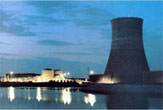Report: Nuclear Power Has Bright Future

Nuclear power has a bright future globally, according to a report released today by the International Atomic Energy Agency (IAEA).
The annual report makes two projections, one assuming all nuclear capacity currently under construction or firmly in the development pipeline gets completed and attached to the grid, but no other capacity is added. In this low projection, there would be growth in global nuclear capacity from 370 gigawatts at the end of 2006 to 447 gigawatts by 2030. (A gigawatt equals 1,000 megawatts).
In the high projection, which adds in additional reasonable and promising projects and plans, capacity is estimated to rise to 679 gigawatts by 2030, for an average growth rate of 2.5 percent per year.
"Our job is not so much to predict the future but to prepare for it," explains the IAEA's Alan McDonald, Nuclear Energy Analyst. "To that end we update each year a high and low projection to establish the range of uncertainty we ought to be prepared for."
Nuclear power's share of worldwide electricity production rose from less than 1 percent in 1960 to 16 percent in 1986, and that percentage has held essentially constant in the 21 years since 1986, the agency reported in a statement today. Nuclear electricity generation has grown steadily at the same pace as overall global electricity generation.
Other findings in the report:
- There were 435 operating nuclear reactors around the world as of the end of 2006, including 103 in the United States, 59 in France, 55 in Japan and 31 in Russia.
- 29 plants are under construction, including 7 in Russia and 15 in various Asian countries.
- Of the 30 countries with nuclear power, the percentage of electricity supplied by nuclear ranged from 78 percent in France to 19 percent in the United States and 2 percent in China, where energy consumption has burgeoned in recent years.
- India, another country experiencing rapid growth in energy use, gets less than 3 percent of its electricity from nuclear but plans to increase that figure to 10 percent by 2022.
"Nuclear power's prominence as a major energy source will continue over the next several decades," the report concludes.
Sign up for the Live Science daily newsletter now
Get the world’s most fascinating discoveries delivered straight to your inbox.
The IAEA was established in 1957 as an autonomous organization under the United Nations. Its mandate is to serve as an intergovernmental forum for scientific and technical cooperation in the peaceful use of nuclear technology.










